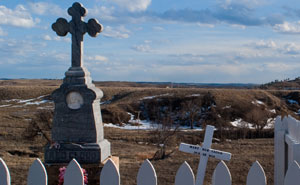Red Cloud Indian School Sites
Historic Cemetery and Chief Red Cloud’s Gravesite
 High on a hill overlooking Red Cloud Indian School’s Pine Ridge campus, the gravesite of Chief Red Cloud, the Lakota warrior for whom the Catholic, Jesuit organization is named after, sits. The great chief’s final resting place is often decorated with tobacco pouches, trinkets and tributes to the Lakota leader, who died on December 10, 1909, at the age of 87. The cemetery also contains the graves of members of the mostly Lakota congregation, as well as the priests, brothers and sisters who belonged to the Jesuits and other religious orders who have worked at Red Cloud Indian School over the organization’s 125-year history. Grave markers document the events that were happening back then, in terms of people who you find that are buried there
High on a hill overlooking Red Cloud Indian School’s Pine Ridge campus, the gravesite of Chief Red Cloud, the Lakota warrior for whom the Catholic, Jesuit organization is named after, sits. The great chief’s final resting place is often decorated with tobacco pouches, trinkets and tributes to the Lakota leader, who died on December 10, 1909, at the age of 87. The cemetery also contains the graves of members of the mostly Lakota congregation, as well as the priests, brothers and sisters who belonged to the Jesuits and other religious orders who have worked at Red Cloud Indian School over the organization’s 125-year history. Grave markers document the events that were happening back then, in terms of people who you find that are buried there
The cemetery is closed to new burials today, but the history of a transitional time period for the Lakota tribe is written in its granite headstones. The graves tell of a nomadic warrior culture rapidly replaced by life on a reservation. There are graves of numerous Lakota men that are also engraved with the words "U.S. Army Scout." The graves of schoolchildren who died while attending the boarding school tell the history of assimilation through the U.S. government's educational policy. The victims of several deadly blizzards that hit in the early 1900s speak of the dangers and deprivations that were part of daily life.
The Heritage Center
Home to some of the finest collections of Native American art in the world, The Heritage Center includes nearly 10000 pieces in a permanent collection of paintings, drawings, traditional clothing, sculptures and artifacts representing a large number of different Native American tribal traditions. The Center showcases a number of special exhibitions each year, including the renowned Red Cloud Indian Art Show each summer. A gift shop features authentic beadwork, quillwork, star quilts and more from local Lakota artisans. Admission is free. Donations are appreciated.
Holy Rosary Church
During the Council of White Clay on September 17, 1876, Chief Red Cloud demanded that the "Black Robes" be allowed to assist his people. When construction began in 1896 on Holy Rosary Mission Church, the fruit of Red Cloud’s hope came to bear. With its main beams planed from nearby trees and its red bricks fired from local clay, Holy Rosary Church was the result of Lakota, Franciscan and Jesuit labors. The church held its first Mass on Christmas Day in 1898.
Unfortunately, the historic church—the first country brick church west of the Missouri River—burned to the ground on Good Friday, April 5, 1996. All that was salvaged was its flame-scarred baptismal font, which exists today in a new church on the grounds of the original one. Dedicated by Bishop Blaise Cupich on October 7, 1998, the new Holy Rosary Church has traditional Lakota stained glass windows that are the result of a collaboration between Red Cloud High School art students under the direction of Lakota Elder Francis He Crow and Fr. Dave Smith, S.J. Four Lakota artists designed and executed the Stations of the Cross, which also hang in the church. Mass is held daily at Holy Rosary.
Historic Mission Building
Dating back to the original mission started in 1888 by Chief Red Cloud and the “Black Robes” (the Jesuits), the Historic Mission Building on the grounds of Red Cloud Indian School in Pine Ridge was built brick-by-brick by Lakota and Jesuits working alongside one another.
Look carefully at the bricks as you walk around the building or along the hallways inside and you’ll notice names carved in the clay of graduates who have since left our schools and go out into the world to create a better world for not just their people, but everyone. The building was once home to dormitories for students. Today, the Historic Mission Building is home to classrooms, administrative offices and The Heritage Center.
